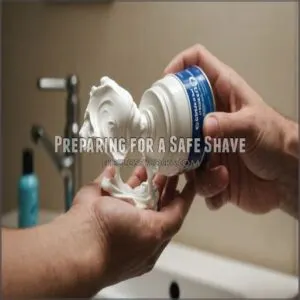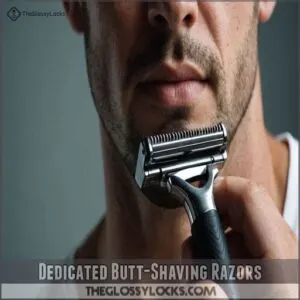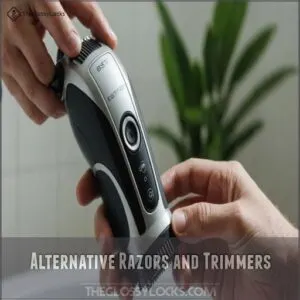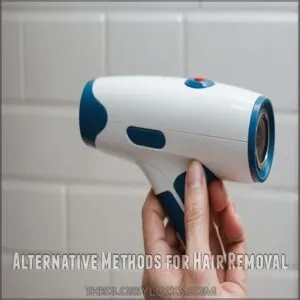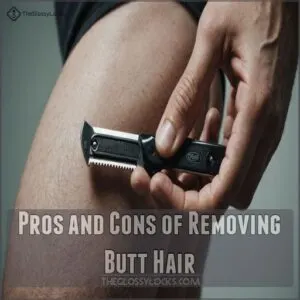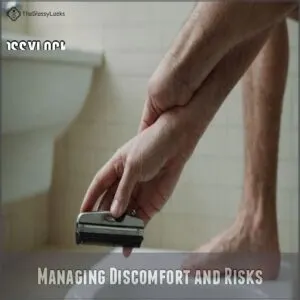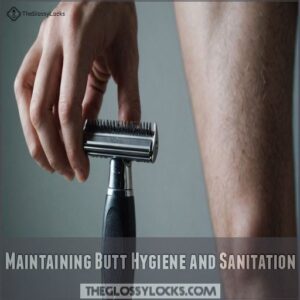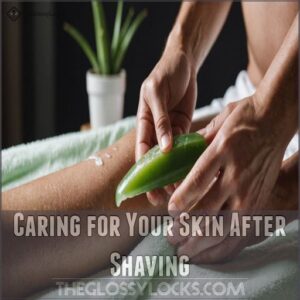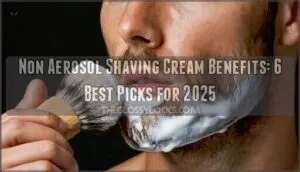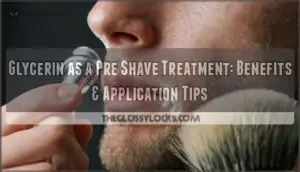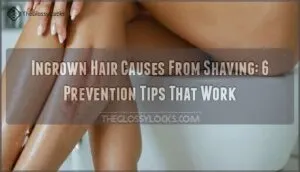This site is supported by our readers. We may earn a commission, at no cost to you, if you purchase through links.
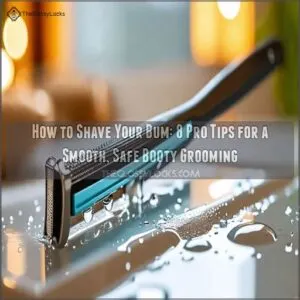 Shaving your bum? It’s trickier than it looks!
Shaving your bum? It’s trickier than it looks!
First, trim the hair down – trust me, it’ll make things easier.
Then, hop in a warm shower to soften things up.
Use a fresh razor, ideally one designed for sensitive skin.
Lather up with a good shaving cream, and shave in the direction of hair growth to avoid irritation.
Don’t press too hard; gentle is key!
Rinse thoroughly and pat dry.
Getting a smooth shave down there might feel like conquering Everest, but with the right technique, you’ll be feeling smooth as a baby’s bottom in no time.
There’s more to it though – read on to discover pro tips for avoiding bumps and irritation!
Table Of Contents
- Key Takeaways
- Preparing for a Safe Shave
- Choosing The Right Shaving Tools
- Alternative Methods for Hair Removal
- Pros and Cons of Removing Butt Hair
- Managing Discomfort and Risks
- Proper Aftercare for a Comfortable Bum
- Maintaining Butt Hygiene and Sanitation
- Caring for Your Skin After Shaving
- Frequently Asked Questions (FAQs)
- Should you shave your butt hair?
- How do I remove hair from my bum?
- Does shaving bum hair reduce sweat?
- What are the bumps from shaving your bum?
- How often should I shave my bum?
- Can shaving my bum cause ingrown hairs?
- Is it normal for regrowth to itch?
- Are there specific razors for butt shaving?
- How to prevent razor burn after shaving?
- Conclusion
Key Takeaways
- Trim your butt hair first to make shaving easier and reduce irritation; use dedicated trimming tools and ensure a well-lit environment for visibility.
- Take a warm shower before shaving to soften hair and open pores, enhancing the shaving experience while reducing the risk of razor burn.
- Choose dedicated butt-shaving razors with features like curved handles and moisturizing strips for a safer, smoother shave.
- Maintain hygiene by properly sterilizing the area before shaving and applying anti-chafing powder and moisturizing afterward to prevent irritation and infection.
Preparing for a Safe Shave
You’re about to become a smooth operator in the bum department, but let’s not rush things.
Before you grab that razor, there are a few important steps to make sure your booty-grooming adventure doesn’t turn into a pain in the you-know-what.
Trimming Butt Hair Before Shaving
The key to a smooth bum is starting with a trim.
Before diving into the full shave, you’ll want to tackle that forest back there.
Trimming your butt hair makes shaving easier and also reduces the risk of skin irritation.
Here are three pro tips for trimming:
- Use dedicated trimming tools for hygiene
- Aim for a hair length of about 1/4 inch
- Trim in a well-lit area, using a mirror for better visibility
Remember, a good trim sets the stage for a safer, more comfortable shave.
It’s like mowing the lawn before pulling out the weeds!
Taking a Warm Shower
Before diving into your bum-shaving adventure, hop in for a warm shower.
This pre-shave ritual softens your hair and opens up those pores, making the whole process smoother than a baby’s bottom.
Spend about 5-10 minutes letting the warm water work its magic.
While you’re at it, gently exfoliate to remove dead skin cells.
Trust me, your booty will thank you for this spa-like treatment!
Sterilizing The Ass Area
Now that you’re squeaky clean, it’s time to sterilize your booty battlefield.
Grab your hygiene essentials and let’s make sure your bum’s as clean as a whistle.
Here’s your pre-shave scrub game plan:
- Lather up with antibacterial soap, getting into every nook and cranny.
- Rinse thoroughly, leaving no soap soldiers behind.
- Pat dry gently – no rough stuff!
Remember, a clean canvas is key for a smooth butt shaving experience.
Your future self will thank you!
Choosing The Right Shaving Tools
You’ll want to pick the right tools for a smooth, nick-free bum shave.
Let’s look at some options that’ll make your booty-grooming adventure a breeze, from dedicated butt-shaving razors to trimmers that’ll have you feeling like a pro.
Dedicated Butt-Shaving Razors
Choosing the right razor for your bum-shaving adventure can make all the difference.
Dedicated butt-shaving razors are designed with your delicate derrière in mind.
They offer features that regular razors just can’t match.
Let’s break down what makes these specialized tools the cream of the crop:
| Type | Features | Benefits |
|---|---|---|
| Curved Handle | Ergonomic design | Easier reach and control |
| Safety Guard | Extra protection | Reduces nicks and cuts |
| Moisturizing Strip | Built-in lubrication | Smoother glide, less irritation |
| Flexible Head | Contours to body | Even shave on curved areas |
| Precision Trimmer | Detailing edge | Tackles hard-to-reach spots |
These razors are your ticket to a smooth, safe shave.
They’re worth the investment for your comfort and peace of mind.
Alternative Razors and Trimmers
You’ve got options beyond butt-specific razors.
Electric trimmers, such as those found on websites that sell products like the electric trimmer for butt, are your best friend for a quick, nick-free trim.
Safety razors offer precision but require a steady hand.
Disposable razors work in a pinch, but watch out for irritation.
Body shavers
Alternative Methods for Hair Removal
If you’re not sold on shaving, there are other ways to tame your tushy tresses.
From waxing for longer-lasting smoothness to zapping those hairs away with lasers, you’ve got options to keep your bum as bare as you dare.
Waxing for a Cleaner Result
Your booty’s smooth future might lie in waxing.
It’s like ripping off a Band-Aid – quick, but ouch!
The pain’s worth it for longer-lasting results.
You’ll need to wax every 4-6 weeks, costing around $50-$100 per session.
The technique? Spread, apply, rip!
It’s not for the faint-hearted, but it beats daily shaving.
Just remember, a pro can make your waxing experience less of a pain in the butt!
Electrolysis for Permanent Removal
Did waxing leave you yearning for something with less sting?
Electrolysis might be your ticket.
It’s more cost-effective for permanent butt hair removal.
Imagine, no more waxing buttcrack pain!
The process zaps hair follicles, reducing hair regrowth effectively.
While it takes several sessions and recovery isn’t instant, many swear by it as a long-term solution to ditch anal hair removal hassles.
Laser Hair Removal for Effective Results
Weighing laser hair removal for butt hair? It’s a solid choice, though it stings a bit.
Remember: To prevent pesky ingrown hairs, you’ll need to be diligent with aftercare.
You’ll need a few visits to zap all that fuzz for good.
Cost: It’s not cheap, but hey, freedom has its price.
Long-term Results: Less hair equals less shaving. Who can argue with that payoff?
Pros and Cons of Removing Butt Hair
So, you’re thinking about shaving your bum? Let’s weigh the good and the bad – a smoother, potentially more confident you versus the risk of irritation and those pesky ingrown hairs.
Improved Appearance and Confidence
Opting for butt hair removal can be a real confidence booster.
Imagine strutting around with a smooth, hair-free backside that complements your personal style.
Shaving your bum might also align with your grooming habits, enhancing your body image and self-esteem.
However, balancing social norms and personal preference is key, so make sure this choice suits your comfort and lifestyle.
Reduced Sweat and Odor
Thinking of sweat reduction techniques and odor control tips?
Removing butt hair can make a world of difference.
You enjoy body hygiene benefits, thanks to less sweat and smell.
Plus, natural deodorants and sweat-wicking fabrics work better on smooth skin!
Here’s what to keep in mind:
- Trim hair before shaving.
- Use a moisturizer post-shave.
- Wear breathable underwear.
Risks of Razor Burn and Infection
While reducing sweat and odor feels fantastic, watch out for razor burns and infections sneaking in.
A warm, moist environment becomes a bacteria playground.
Keep hygiene practices sharp.
Applying a soothing aftershave can help ease the irritation, but be mindful of the ingredients to avoid further irritation.
Funny how a quick shave can lead to major hassle if you’re not careful.
Remember this table:
| Risk | Prevention Tip |
|---|---|
| Razor Burn | Use gentle strokes |
| Ingrown Hairs | Exfoliate regularly |
| Folliculitis | Sterilize razor |
| Bacterial Infection | Maintain cleanliness |
Managing Discomfort and Risks
When shaving your bum, it’s important to keep things smooth and avoid pesky bumps and infections.
Managing discomfort with a pinch of patience and a bit of prep can make all the difference between a proud strut and an awkward waddle.
Preventing Razor Burn and Bumps
After boosting your confidence by zapping away those pesky hairs, it’s time to keep your rump smooth and bump-free.
Prevent razor burn and bumps with a few easy tricks:
For best results, consider investing in a specialized tool, such as a bum razor.
- Use a sharp razor: Makes for clean cuts.
- Exfoliate gently: Clears
Avoiding Infection and Folliculitis
So, you’ve avoided razor burn – awesome.
Now, let’s tackle infection.
Proper Hygiene Practices are key; clean your razor and the area thoroughly.
Using a gentle shampoo for folliculitis can also help prevent irritation and infection.
A sharp Razor Choice minimizes cuts, lowering your risk of folliculitis.
Remember, shaving bum hair isn’t a race; take your time!
Exfoliating for Smooth Skin
Think of exfoliation as a friendly chat for your skin—aiming for smooth, glowing results.
Grab exfoliating tools or whip up DIY scrubs to gently buff away dead skin.
Finding your perfect scrubbing frequency helps ward off pesky razor bumps and ingrown hairs.
Remember, sensitive skin might need a gentler touch, so adjust your approach for the best benefits of exfoliation.
Proper Aftercare for a Comfortable Bum
Taking care of your bum after a shave isn’t just about comfort, it’s about keeping things smooth and happy.
Use anti-chafing powder and make sure you’re wearing the right underwear to keep any friction at bay and enjoy a worry-free day.
Applying Anti-Chafing Powder
Your butt will thank you later.
Applying anti-chafing powder after shaving, like a blissful cloud, will help prevent friction and keep things comfortable.
Look for the best powder types to reduce sweat and irritation.
Use powder application tips to master this art—just a sprinkle in the right spots does wonders.
Your smooth, comfortable bum will feel like a dream.
Choosing The Right Underwear
You’ve dusted on anti-chafing powder; now let’s talk underwear.
Choose the right pair for comfort after shaving your butt.
Consider these:
- Fabric: Pick cotton for breathability.
- Fit: Make sure you have a snug but not tight fit to prevent irritation.
- Moisture-wicking: Keeps you dry and comfy.
- Support: Offers gentle support without squeezing.
Your bum will thank you!
Maintaining Butt Hygiene and Sanitation
Keeping your freshly shaved bum clean is more important than you might think, especially given how easily bacteria can thrive in warm, moist spots.
Freshly shaved bum hygiene is important.
Make sure to use a bidet for a thorough wash or grab some adult wet wipes for quick touch-ups on the go—your bum will thank you!
Keeping The Area Clean
After caring for your bum, keeping it clean is non-negotiable for avoiding infections.
Suds up with a proper showering routine, focusing on anal care for pristine hygiene.
Sanitary shaving tools make all the difference.
Wrap it up with these must-follow steps:
| Hygiene Tip | Why It Matters | Emotional Impact |
|---|---|---|
| Shower properly | Removes bacteria | Feel refreshed |
| Clean tools | Prevents infections | Peace of mind |
| Pat skin dry | Reduces irritation | Enjoy comfort |
Using a Bidet for Thorough Cleaning
Many find bidets incredibly helpful for thorough cleaning after shaving.
They offer a gentler, more invigorating clean than toilet paper alone.
Consider these bidet benefits:
- Improved hygiene.
- Reduced irritation.
- Enhanced comfort.
Choosing the right bidet type—from simple attachments to high-tech models—depends on your bathroom setup and budget.
Proper bidet installation and maintenance are key to a positive experience.
Using Adult Wet Wipes for Quick Cleanups
Imagine that after shaving your bum, you keep wet wipes handy for a quick cleanup.
They’re a lifesaver for avoiding irritation and maintaining hygiene.
Different types offer unique benefits, so choose wisely!
| Wet Wipe Types | Wipe Usage Tips | Hygiene Benefits |
|---|---|---|
| Aloe Vera | Gentle wipe | Soothes skin |
| Fragrance-Free | Use twice daily | Prevents irritation |
| pH-Balanced | Post-toilet | Maintains balance |
Caring for Your Skin After Shaving
Caring for your freshly shaved skin is like tending to a new plant—gentle care encourages the best results.
Soothe any irritation with aloe vera gel.
Keep things clean to avoid infections.
You can enjoy a smooth, happy bum without any fuss.
Using Aloe Vera Gel for Soothing
Once your butt is squeaky clean, getting comfy post-bum shaving is key.
Aloe vera gel sings praises as it soothes razor burn and offers natural remedies for skin irritation. You can find a variety of products like this on the Aloe Vera Gel Market.
Try this:
- Apply a generous dollop of aloe vera gel.
Avoiding Irritation and Infection
After shaving, keeping irritation and infection at bay is key. Apply an after-shave serum to soothe razor burn and bumps.
Remember, just like with facial shaving, using non-comedogenic shaving products can help prevent breakouts and irritation.
Proper hygiene and careful shaving techniques help stop issues like folliculitis.
Remember, prevention is better than cure!
| Concern | Tip | Reason |
|---|---|---|
| Razor bumps | Use after-shave serum | Soothes skin |
| Infection risk | Practicing shaving safety | Reduces folliculitis chance |
| Skin care | Maintain proper hygiene | Keeps irritation under control |
Practicing Good Hygiene Habits
You’ve tackled preventing irritation, now let’s chat about keeping your freshly shaved bum happy and healthy.
Practicing good hygiene habits is your golden ticket!
Keep the area clean by washing gently with a mild soap daily.
Moisturize to soothe the skin and avoid pesky infections.
Remember, a little care goes a long way in butt shaving success!
Frequently Asked Questions (FAQs)
Should you shave your butt hair?
Imagine trimming a hedge: it keeps things neat but requires effort.
Shaving your butt hair can boost confidence and reduce sweat, but it might lead to irritation.
Weigh the benefits against the risks before deciding.
How do I remove hair from my bum?
Grab your trimmer or razor for a swift shave, but don’t forget shaving cream.
Waxing pulls off hair for longer results, while creams offer quick fixes.
Laser and electrolysis give longer-lasting results, though they require multiple sessions.
Does shaving bum hair reduce sweat?
Shaving your bum hair might make you feel a bit cooler, but it doesn’t necessarily reduce sweat.
Sweat glands aren’t affected by hair removal, so while you’ll feel smoother, your sweat levels probably won’t change much.
What are the bumps from shaving your bum?
Those pesky bumps after shaving your bum are usually razor burn or ingrown hairs.
They pop up when hair curls back into the skin.
To avoid them, shave gently, exfoliate regularly, and keep the area moisturized.
How often should I shave my bum?
Consider shaving your bum every one to two weeks, depending on how quickly your hair grows and personal comfort.
If you prefer smooth skin, you’re the boss—adjust the schedule as needed, but avoid irritation from over-shaving.
Can shaving my bum cause ingrown hairs?
Yes, bum shaving can definitely lead to ingrown hairs.
It’s a common problem, especially in sensitive areas.
To minimize this, use a sharp razor, shave with the grain, and moisturize afterward.
Gentle exfoliation can also help.
Is it normal for regrowth to itch?
That itch is a common companion when hair regrows, like having ants in your pants.
It happens because the hair’s sharp ends irritate the skin.
Keep the area moisturized to help soothe the discomfort.
Are there specific razors for butt shaving?
You can find razors designed specifically for sensitive areas, making them great for butt shaving.
Look for those with pivoting heads and protective guards to prevent nicks.
They’re like tiny, friendly bodyguards for your behind!
How to prevent razor burn after shaving?
Did you know 68% of people experience razor burn at some point?
Zap those potential burns with these tricks: use moisturizer, shave in the hair’s direction, and don’t skip that after-shave treatment.
Your skin will thank you!
Conclusion
Imagine this: a smooth glide without worries versus the rainforest of bumps and irritation.
Shaving your bum doesn’t have to be a challenging task if you follow these pro tips.
With proper preparation, the right tools, and a bit of aftercare, you can achieve a smooth, comfortable booty that boosts your confidence while reducing sweat and odor.
Remember, gentle is key, and managing risks guarantees a safe shave every time.
Happy grooming, and enjoy the results!

